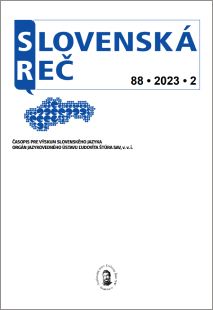Kompozitné pomenovania s internacionálnymi numerálnymi komponentmi v slovenčine
Compound Lexical Units with International Numerical Components in Slovak
Author(s): Martin Ološtiak, Slavka OriňákováSubject(s): Language studies, Language and Literature Studies, Theoretical Linguistics, Lexis, Semantics, Pragmatics, Western Slavic Languages
Published by: Jazykovedný ústav Ľudovíta Štúra Slovenskej akadémie vied
Keywords: Slovak; compounding; international numerical components (combining forms, prefixes); etymology; semantics; word-formation; collocability; frequency; pragmatics
Summary/Abstract: The article deals with compounds with international numerical components in Slovak, e.g. kilogram, nanofarad, monografia 'monograph', polysémia 'polysemy'. These components are defined as bound morphemes with full lexical meaning that can be combined with words (nanotechnológia 'nanotechnology', unilaterálny 'unilateral'), or with bound morphemes (trilógia 'trilogy', pentatlon 'pentathlon'). The former type of compounds is referred to as semi-compounds, the latter as quasi-compounds. The article is structured into four basic sections (apart from introductory notes and conclusions). Methodological background is presented in section 2 where fundamental notions are introduced (including an overview of the principles of word-formation motivation and the classification of compounds). The study of 48 components (i.e. combining forms called baseoids) is presented in the form of "microentries" with information on etymology, semantics, word-formation, frequency (corpus-based data), collocability and the treatment of these entries in selected Slovak dictionaries. In this way two types of combining forms are considered: a) SI metric prefixes: 24 components that signify decimal powers ranging from 10–30 to 1030, e.g. mili-, centi-, kilo-, mega- etc. (section 3); b) non-SI elements: other 24 components with numerical meanings (from "one" to "nine", "half", "many"), e.g. mono-, uni-, tri-, poly- etc. (section 4). Finally, section 5 summarizes corpus data on frequency, examines paradigmatic relations (lexical fields, synonymy, antonymy), polysemy and orthography, and characterizes communication status (words with international combining forms are typical for the languages for specific purposes, i.e. language of science and technology).
Journal: Slovenská reč
- Issue Year: 88/2023
- Issue No: 2
- Page Range: 63-105
- Page Count: 43
- Language: Slovak

